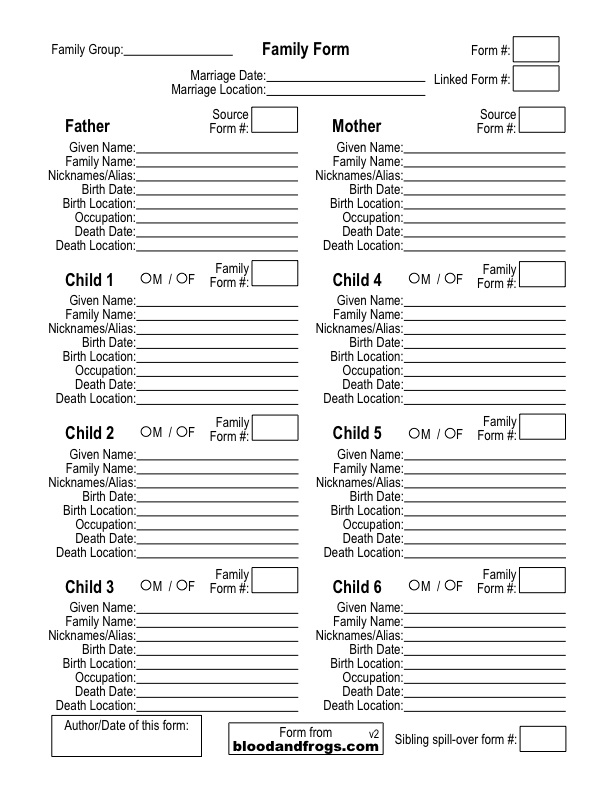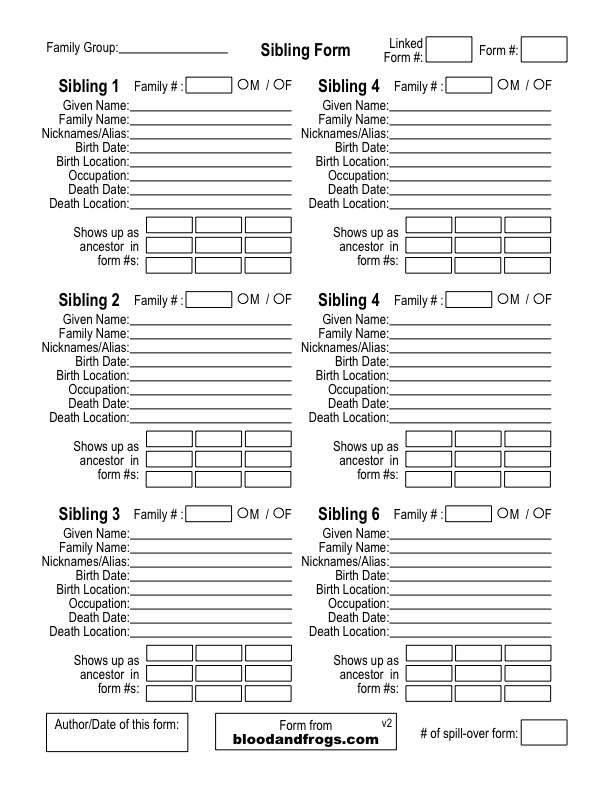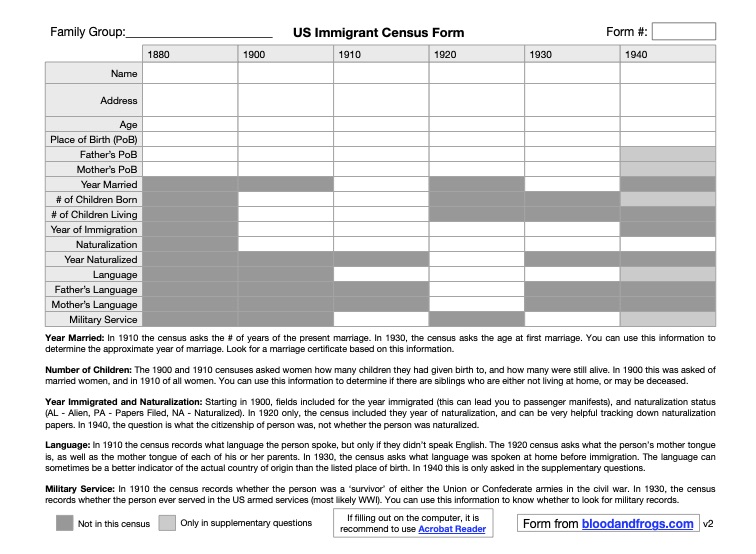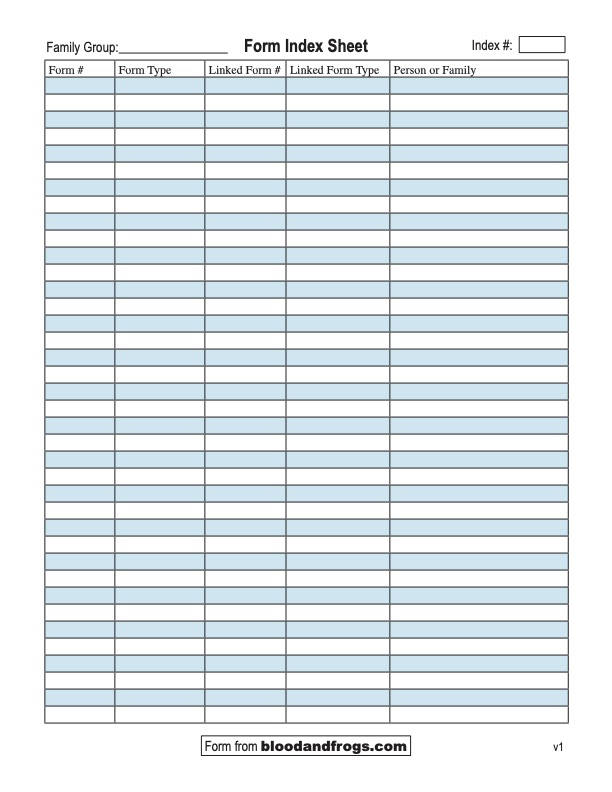Contained on this page are links to forms that are part of the free B&F Forms System.
(For Hebrew forms, see the Hebrew Forms page.)
These forms are designed to work together. For example, you can use a Sibling form to add children to a Family Form, or use it as a list of siblings of a Source Person or one of their parents on the Ancestor Form. When you fill out a Family Form for parents that are in an Ancestor Form, you can link the two by adding the number of the Family Form to the Ancestor form (between the names of the parents).
These forms are designed to print equally well on Letter size paper (for North American users) and A4 paper (for everyone else). The forms can be printed and then filled out, or filled out on the computer and then printed. If you don’t want to print them at all, just fill out the form and save it as a new PDF, and you won’t need to waste any paper.
Some users of Adobe Reader have reported problems saving the forms, but all you need to do is use the ‘Save As…’ menu item instead of ‘Save’ and it should work fine. Just save a different copy of the form for each person you are filling it out for, and add the person’s name to the file name. On the Mac you can also use Preview, which comes with your computer, to fill out the forms.
A neat feature of the PDF forms is that if you fill out a name and it seems that it will be longer than the field allows, it will actually shrink the letters so they all fit visually once you leave the field. This works best using Adobe’s Acrobat Reader application.
You can add comments about the forms to the bottom of this page. Please let me know what you like or don’t like about them. They have already been revised once based on user feedback, and may be revised in the future as well.
If you teach a course in genealogy and want to use these forms with your students, feel free, but please send me an e-mail to let me know they are being used.
Ancestor Form
The Ancestor Form is what is usually called a pedigree chart.
You fill in information on yourself, your parents and your grandparents. For yourself and your parents you can link to Sibling forms to add siblings. For your grandparents you can link to another Ancestor Form where they are the Source Person instead of you.
On the top left of the page, you can add a ‘Family Group’ name, which is the surname you want to organize this file under. You don’t need this, but it can make organizing the forms easier.
On the top right, you assign the form a number. Make sure to add the number and other details to the Form Index Sheet to help you keep track of all your forms.
Family Form
The Family Form is a form that lets you fill out information about a nuclear family – parents and children. There is room for two parents and up to six children.

If you need to add more than six children, you can use a Sibling Form for the spill-over. Just add the number of the spill-over form to the box on the bottom right so you know which form is connected to which.
For each parent in this form, if they show up a Source Person in an Ancestor Form, you can write in the number of that form in the box next to their name on this form.
For each child in this form, if you have a Family Form for them, you can write in the number of the Family form in the box next to their name on this form.
Sibling Form
The Sibling Form can be used to show the sibling(s) of a Source Person or their parents in an Ancestor Form, or as spill-over for the Family Form for families with more than six children.
On the top right of the form you fill in both a form number for this form, and a linked form number for the form it is connected to, such as an Ancestor Form or a Family Form.
Like the Family Form, you can add the number of a Family Form for each sibling if you have a Family Form for them.
If the sibling listed shows up as an ancestor in other forms (such as a grandfather in an Ancestor Form) you can list the form numbers where they show up in the fields provided.
Ancestor Location Form
The Ancestor Location Form is more of a specialist research form. You fill the form out with the names of your parents, grandparents and great-grandparents, along with their birth dates and birth locations.
The concept of the form is to allow you at quick glance to see all the locations and dates relevant to your immediate research.
This form is helpful for seeing quickly what pieces of information you are missing. If you don’t have a birth date for one ancestor, or a location for another, it will help you focus on the next steps in your research.
For Jewish researchers, you can fill out this form before adding your family names to the JewishGen Family Finder to make sure you don’t leave any surname/location combinations out.
US Immigrant Census Form
The US Immigrant Census Form is intended to help genealogists, both beginners and experienced, to focus their research efforts. This form helps you to collect information from US Federal Censuses between the years 1880 and 1940. This does not include 1890, as the 1890 census was almost completely destroyed by a fire. The focus of this form is to collect the information that is useful in finding out more information about this particular immigrant.
This form does not cover censuses before 1880, but by all means you should check those if the person you are researching lived in the US during an earlier census. The reason the form starts in 1880 is partly due to space issues, partly due to more useful information being collected in later censuses, and partly because of the large number of immigrants that arrived in the 1870-1940 period.
Form Index Sheet
As you might guess, the Form Index Sheet form simply exists to help you keep track of the other forms. Each time you fill out a new form and assign it a number, add the form to one of these pages.
When a form is specifically linked from another form (such as a Sibling Form) there are fields for showing which form it was linked from.





Well I’m impressed The forms are ‘new’ to me and they look as if they will form an intergal part of my family history.
I need a form to record what research I have done please ?
I’m not sure what you’re asking. There are several useful forms on this page you can use to record your research. Read the descriptions of the forms above and click on the form image to download the form itself as a PDF file.
You need a research log. You can find them all over the Internet, or look on Cyndis list.
Have you updated the US Census form to include the 1940 US Federal Census?
Unfortunately no, as I no longer have access to the program I used to design the forms. I’ve been waiting for the release of a different program which is happening later this year or early next year, and then I hope to re-create the form with the 1940 census.
TOTALLY LOVING THESE!!! Thx so much for sharing your hard work with us!!!! That is/was EXTREMELY kind & helpful!!! Blessings!
You’ve done a wonderful service for the genealogy community. For those interested, and the occasional collector, I have several more forms at http://shoestringgenealogy.com/form.html. Good going!
These will be great forms for my beginners genealogy class-4th grade-at the Jewish Academy of Orlando
Please use them for your class. I’d love to hear if they have any issues with them, and how they worked out.
The Family Form only goes to “child 6” I have family members who have more than 6 children like my grandparents. Is there another form that starts with “child 7?”
Thank you for using my forms. On the bottom right of the Family Form you’ll find a box labeled ‘Sibling spill-over form #’. You use a Sibling Form, number it, and put that number in that box on the Family Form. On the Sibling Form, next to where you assign a form #, there is a box labeled ‘Linked Form #’ and there you put the number of the Family Form it is connected to, so you can easily find which forms are connected in either direction.
I love your forms. I am looking for a Census Timeline Chart.
Thanks, Kitty B. Hoffman
Thank you, I’m glad you like the forms. Please explain in more detail what you’re looking for, and how it differs from my US Immigrant Census Form.
I am excited to find the census form. It is exactly (minus the 1940 census) what I wanted!
Hi, I love your forms and just started using them and would love to be able to change the child number on the sibling form.
im using the family form but for families with more then 6 kids id like to be able to change the sibling form so i can put child 7, child 8 etc
Thank you. Interesting. That makes sense, but does complicate things a bit. Maybe I could simply make a version of the Sibling form without numbers, and you could fill in the number. Or I could actually make an extension of the family form that was labeled Child 7-12. Unfortunately, I don’t have the software I used to create the original forms, but I will see what I can do.
What about a form for people who are adopted by a Jewish family and need to start with DNA and then create the paper trail to find their biological family and it’s ethnicities? You form is for a traditional family with room for only 2 parents not 2 adoptive and 2 biological. I’m helping a friend born before 1946 who has this delema and the truth was never shared it was hidden. Will the 1950 census suddenly reveal the secrets and be able to be documented?
I’m not currently making new forms, although I’m not sure why you need a different form. If you’re researching a biological family through DNA then do that on one form. My forms are research tools, they are not intended to be the final presentation of one’s family tree.
As for the 1950 Census that should be released in 2022.
When you get your software please consider creating forms for nontradional family situations. In adoptions names at birth are rarely the name after adoption. Yet it is the same person. Just using form reference numbers may cause confusion and duplication.
Thanks for the forms. Will you be updating or adding a 1950 Census Form and an Ancestor Timeline form to keep track of each person through a visual timeline?
Appreciate your hard work as a newbie in Jewish research.
I hope to update my census for the 1950 census, I just haven’t had the time yet.
Hello. Thank you for the fine work you have done in creating these very useful forms. I was wondering if you can answer which may seem like a very simple question. I am at a loss on how these forms worked together or more specifically how they are numbered. Assuming that you use a standard Pedigree Chart where you are number One, then you want to use the B&F Family, Sibling and Ancestor Forms, how would you assign the Form Nos., Linked Form Nos and Source Form Nos? Do you assume the entire Pedigree Chart is Form 1 and then the Linked Nos are the numbers assigned from the ancestors, whereis your father is Linked or Sourced Form #2…? I have looked everywhere and cannot find an answer that actually speaks to the forms and not the Ahnentafel or register number system. Thank you in advance.
My forms don’t use a numbering system such as Ahnentafel. The way the numbers work is that each time you create a new form, you number it (and can track those numbers on the Index sheet if you want). Let’s say you were to use the Ancestor form (my version of a pedigree form) for example, and added your information and that of your parents and grandparents. Let’s say you numbered that form number 1. Now you wanted to continue with Ancestor forms for each of your grandparents. You could add a form for each of them, so the form where your paternal GF was the source could be form number 2, paternal GM could be form number 3, maternal GF could be form number 4, and maternal GM could be form number 5. On the top right of each form you put it’s own number. On form number 1, however, you would add numbers 2-5 in the appropriate boxes next to your grandparents. If you want to add information on your siblings without filling out a new Family Form (which would be a bit repetitive if you already filled out an Ancestor form, then you could add your siblings on a Sibling form, let’s say form number 6, and add the 6 to the box next to your name on form number 1. The idea here is two-fold. First, you want to simply know that there is additional information on other forms. Second, you want to easily move among the forms, so when looking at one form, you know which other forms have related forms you need to look at. I hope this all makes sense.
It does! Thank you!! So, when moving to the B&F Family Form (which I love), from the B&F Ancestor Form, my parent’s would be on Family Form No. 1, and their siblings would be Siblings Form Nos 1 (Father) and 2 (Mother) correct? Then that leaves me confused on the numbering, or flow of forms for my grandparents? I understand the numbering going from Ancestor form to Ancestor form, but am uncertain about the Family forms. Would my Paternal grandfathers Family Form be Numbered Form #1, Linked from Form (Ancestor Form) #1 (where I am the source person) or #2? I think I am making this far more difficult than it really needs to be. I am trying to start documenting manually (with paper) as in the past I have only documented online, now family wants information and not everyone wants or is willing to purchase the online programs. I think that’s my biggest struggle. Thank you for your work. Victoria
All form numbers should be unique. It doesn’t matter what kind of form it is. The Family Form was designed specifically so you could send it to a relative and have them fill out the information about their immediate family, and then send it back to you. You can then number it however you want. Not all forms need to be connected to other forms. Consider if you sent Family Forms to twenty cousins. You could number those 1-20. You could then add other family forms where one parent in one of the 1-20 family forms is now a child, and you’re connecting them to their siblings and parents using a new family form. Or if none of the 20 cousins were siblings, you could add new Ancestor forms for each of them and add their parents and grandparents. The system is meant to be flexible.
Okay, I see. I am trying to be too restrictive. This makes a lot more sense. I was thinking that every form had to have a linked form, a source form and a main form. Thank you very much. Victoria
Thank you for all your time! I have a much better handle on how these forms work together.
I love these forms! They are exactly what I have been trying to do with my genealogy research. I’m not Jewish though, does that matter?
I’m glad you like the forms. Anyone can use the forms, there is nothing Jewish-specific to them.